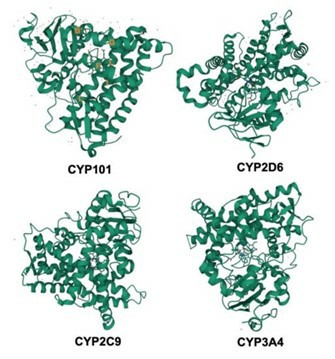Effects of Cytochrome P450 Metabolism on Drug Interactions
Cytochrome P450 enzymes, as a superfamily of heme-containing enzymes, are involved in the oxidative metabolism of an extensive range of xenobiotics, including drugs and environmental chemicals. This serves as a prime determinant of drug bioavailability and clearance, ultimately influencing therapeutic efficacy and safety profiles. Cytochrome P450 enzymes are essential for the metabolism of many medications. Although this class has more than 50 enzymes, six of them metabolize 90 percent of drugs, with the two most significant enzymes being CYP3A4 and CYP2D6. Genetic variability (polymorphism) in these enzymes may influence a patient's response to commonly prescribed drug classes, including beta blockers and antidepressants. Cytochrome P450 enzymes can be inhibited or induced by drugs, resulting in clinically significant drug-drug interactions that can cause unanticipated adverse reactions or therapeutic failures.
Cytochrome P450 Isoforms and Substrates
Notable CYP isoforms include CYP3A4, CYP2D6, CYP2C9, and CYP1A2, among others. Each isoform possesses a unique substrate specificity profile, with some enzymes exhibiting broad substrate specificity while others are more selective. For example, CYP3A4 is involved in the metabolism of approximately 50% of clinically used drugs, including immunosuppressants, anti-cancer agents, and antiretroviral medications. On the other hand, CYP2D6 is responsible for metabolizing a significant number of psychotropic drugs, beta-blockers, and opioids.
 Fig. 1 A representative example of known CYP structures. (Zhao M, et al., 2021)
Fig. 1 A representative example of known CYP structures. (Zhao M, et al., 2021)
The genetic polymorphisms and allelic variations associated with CYP isoforms can lead to substantial inter-individual variability in drug response. Certain polymorphisms can result in altered enzyme activity, affecting the metabolism of specific substrates and contributing to diverse drug responses among individuals. For instance, poor metabolizer phenotypes for CYP2D6 may lead to diminished therapeutic efficacy of drugs that are primarily metabolized by this enzyme, while ultra-rapid metabolizers may experience increased drug activation and potential toxicity.
Drug Interactions Involving Cytochrome P450
Drug interactions involving CYP enzymes are of substantial clinical relevance, as they can significantly impact the pharmacokinetics and pharmacodynamics of medications. These interactions primarily manifest as enzyme inhibition or induction, leading to altered systemic exposure of co-administered drugs metabolized by the same CYP isoform. Understanding these interactions is essential for predicting and managing potential adverse effects, ensuring optimal therapeutic outcomes, and minimizing the risk of toxicity.
- Enzyme inhibition. Drugs that inhibit specific CYP isoforms can impede the metabolism of co-administered drugs, resulting in elevated systemic drug concentrations. This can potentially lead to enhanced therapeutic effects or increased risk of adverse effects, including toxicity. For instance, co-administration of the antifungal agent ketoconazole, a potent inhibitor of CYP3A4, with drugs metabolized by CYP3A4 can substantially elevate their plasma concentrations, necessitating dosage adjustments to alleviate the risk of toxicity.
- Enzyme induction. Conversely, some drugs can induce the activity of specific CYP isoforms, accelerating the metabolism of co-administered drugs and reducing their systemic exposure. This can lead to sub-therapeutic drug levels and compromised efficacy. For example, the concomitant use of rifampin, a potent inducer of CYP3A4, with certain oral contraceptives can diminish their efficacy by increasing their clearance.
Adverse Drug Interactions Related to Cytochrome P450 Metabolism
Adverse drug interactions stemming from cytochrome P450 metabolism are a well-documented concern in clinical practice. Notable examples include the co-administration of statins (e.g., simvastatin) with inhibitors of CYP3A4, resulting in an augmented risk of statin-induced myopathy, or the concurrent use of warfarin with compounds that influence CYP2C9 activity, potentiating the risk of bleeding. The clinical significance of these interactions underscores the critical need for comprehensive evaluation of drug-cytochrome P450 interactions during drug development and post-marketing surveillance.
Creative Bioarray Relevant Recommendations
Creative Bioarray is a renowned biological company with a wealth of experience in offering a diverse array of CYP Activity and Inhibitor products and services. Leveraging our expertise in pharmaceutical research and development, we provide high-quality tools and resources to support the investigation of CYP-mediated drug interactions and metabolism.
Reference
- Zhao M, et al. (2021). "Cytochrome P450 Enzymes and Drug Metabolism in Humans." Int J Mol Sci. 22 (23), 12808.